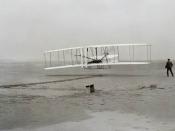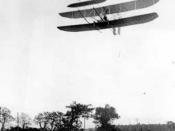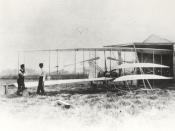Inventing the Airplane
In 1896, the newspapers were filled with accounts of flying machines. Wilbur and Orville noticed that all these primitive aircraft lacked suitable controls. They began to wonder how a pilot might balance an aircraft in the air, just as a cyclist balances his bicycle on the road. In 1899, Wilbur devised a simple system that twisted or "warped" the wings of a biplane, causing it to roll right or left. They tested this system in a kite, then a series of gliders.
They made their first test flights at Kitty Hawk, North Carolina, on the shores of the Atlantic where the strong winds helped to launch the gliders and the soft sands helped to cushion the fall when they crashed. Their first two gliders, flown in 1900 and 1901, failed to perform as the Wrights had hoped. The gliders did not provide enough lift nor were they fully controllable.
So during the winter of 1901-1902 Wilbur and Orville built a wind tunnel and conducted experiments to determine the best wing shape for an airplane. This enabled them to build a glider with sufficient lift, and concentrate on the problem of control. Toward the end of the 1902 flying season, their third glider became the first fully controllable aircraft, with roll, pitch, and yaw controls.
During the winter of 1902-1903, with the help of their mechanic, Charlie Taylor, the Wrights designed and built a gasoline engine light enough and powerful enough to propel an airplane. They also designed the first true airplane propellers and built a new, powered aircraft. Back in Kitty Hawk, they suddenly found themselves in a race. Samuel P. Langley, Secretary of the Smithsonian Institution, had also built a powered aircraft, patterned after a small, unmanned "aerodrome" he had flown successfully in 1896. To...


